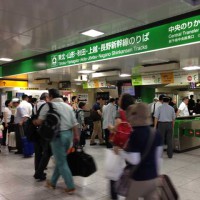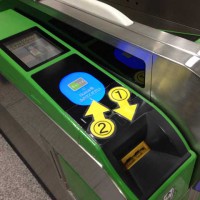東北新幹線の改札 その1
2014年09月01日(月) 15:53
UXいろいろ, 日本発信四方山話, 東京, サインやUIの話, ヒトについて, モノ+コトの話JR GATE FOR TOHOKU SHINKANSEN 1: Since JR (Japan Railways) introduced IC cards, the gate for Shinkansen (bullet train) has needed to take care of a combination of traditional paper ticket and IC card ticket. Passengers feel that they need to pay for fares up to the current station first by touching the IC card to the reader on the gate, and to insert the paper ticket for Shinkansen to the slot next. As the Shinkansen ticket, however, include fares from any station in a certain area of Tokyo, the gate needs to receive the paper Shinkansen ticket first to avoid receiving duplicate payments. The gate was not unfortunately designed to tell the system and procedure, but the gate staff from JR East added the notes as the picture shows, which should have helped both the passengers and gate staffs, and I’m very much curious to know how much helpful it has turned out to be.
2月、はじめて東北新幹線を利用して(しかもいきなりグランクラスってみたりとか…)仙台へ行ったのを皮切りに、今年はJR東日本率いる東北新幹線に大変お世話になっています。
IC乗車券の導入により、東京駅まではICカードで来たけれど、新幹線は切符でというお客さんが現れました。そして改札で迷う。どっちが先だ?と。ユーザーの心理としては、ICカードをタッチしてここまでの乗車を精算してから、次に乗る新幹線の切符を入れる…という流れが自然…なんだろうな、たぶん。
しかし新幹線の乗車券には東京都区内の乗車料金が含まれているため、ICカードで先に精算してしまうと二重払いになってしまう区間が出る可能性がある。それを防ぐため(だと思う)に改札機は、新幹線の切符(というか正確にはそこからの乗車券)を先に入れることを求めるのでした。
よほど間違う人が多いからでしょうか、東北新幹線の改札機には①切符、②Suicaという順番を伝える後付けの情報がありました(写真[2])。作り手と使い手の概念モデルが一致していない場合に発生する問題の好例と言えそう。その問題による影響を最小限に抑えるために利用現場が為した工夫としても好例。果たしてこれで、どのくらい間違いを防げているのか…、気になりますね。


